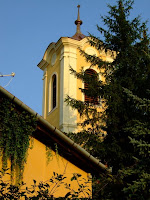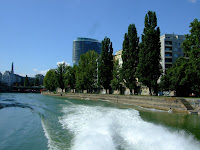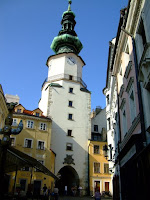
15C and rain in London? 30C and sun in Vienna? It was a tough choice but having woken to glorious sun in Vienna this morning, we decided to stay and explore the city.
Our hotel was just across the river from the centre of Vienna so we made our way to Stephansplatz to have a look at St Stephan's Cathedral with its attractive patterned roof. Along the Graben we checked out another local tourist attraction, the underground loos designed by Aldof Loos and the beautiful baroque Peterskirche with its wonderful frescoes.

An unusual extra in this church are two glass-fronted shrines enclosing the bones of two martyrs brought from the catacombs of Rome in 1730, The bones are clothed in the style of the period with cut-outs in places so that the bones can be seen. All quite macabre really.
There was obviously lots about to happen in the gardens in the Hofburg as people we setting up f

or a country-comes-to-the-city festival of some sort but we wandered on through the museum quarter and down to the Naschmarkt that, unlike the festival area, was in full flow with thongs of people jostling past the stalls. Exiting the far end we checked the map and found we still had about 7 km to go to the Shloss Schonbrunn, that earlier information had indicated was only 20 minutes away - clearly not on foot.

Time for the U-bahn and, fortunately, the station we were near was on the direct line to Shloss Schonbrunn. When the palace was built it was far enough away from Vienna to be the summer palace, now it is a short ride on the U-bahn.
After carefully considering which ticket combination to purchase we settled on the Classic Pass which afforded us the extended palace tour, entrance to the Privy Garden, the Gloriette at the top of the hill, the Maze and the Apple strudel show.

The strudel show was well worth it; watching the chef spin a smallish lump of dough out to an area that wasn't much short of a square metre and so thin you could read through it, was quite amazing.
The palace and formal gardens are quite stunning and wandering though the rows of trees, all meticulously manicured into vertical walls where they fronted a path, allowed us to stumble across all

manner of extra delights that did not seem to be mentioned in the information we had been given.
Maire Antoinette was a famous daughter from this palace, Napolean's son was "confined to barracks" here for his short life to keep him out of the political arena, Mozart played here for the Empress when he was 6 and Kruschev

and Kennedy first met here for a Summit in 1961, so it has seen a fair chunk of history.
On our way back to the hotel we enjoyed the tail-end of the afternoon with a cold drink and a sun-lounger on a "beach" of golden sand on the banks of the river.

 The second largest Jewish Synagogue in world is in central Budapest and, built in a Moorish style, is quite a magnificent building. The stainless steel weeping willow tree in the grounds is a holocaust memorial with each leaf inscribed with the name of a victim.
The second largest Jewish Synagogue in world is in central Budapest and, built in a Moorish style, is quite a magnificent building. The stainless steel weeping willow tree in the grounds is a holocaust memorial with each leaf inscribed with the name of a victim. our way back to our very centrally located lodgings.
our way back to our very centrally located lodgings. them was assembled in Memento Park. This lies southwest of the centre just outside the city limits so is a bit of a hassle to access. There are tourist tours that go once per day for 3950 HUF but if you make your own way there it costs 2440 HUF.
them was assembled in Memento Park. This lies southwest of the centre just outside the city limits so is a bit of a hassle to access. There are tourist tours that go once per day for 3950 HUF but if you make your own way there it costs 2440 HUF.










































